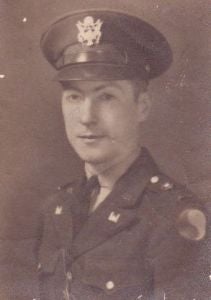- Major
- WW II
Biography
James (Jimmy) Edward Foley was born in Massachusetts on 10 March 1913 to Thomas J. Foley and Mary A. Foley. The Foley family moved to Newport, Rhode Island when Jimmy was a youngster. He was a 1931 graduate of Rogers High School where he was an outstanding scholar and athlete.
In September 1931, Jimmy entered Rhode Island State College with the class of 1935. He was a member of Beta Phi Fraternity, Boxing Champion in the 150-pound class, member of the Beacon Staff, International Relationship Club and participated in intramural track and baseball. He was a member of the Army ROTC Program and was commissioned a Second Lieutenant, Engineer Corps, upon graduation with a Bachelor of Science in Business Administration. Prior to entering active service, just before the Japanese attack on Pearl Harbor, Lieutenant Foley was employed in Washington, DC, where he was studying law and was a member of the Washington, DC, Army National Guard.
Lieutenant Foley was initially assigned to the Pacific Theater where he was awarded the Bronze Star for valor and the Purple Heart for wounds received on Guadalcanal. After serving 27 months in the Pacific Theater, Captain Foley was assigned to the European Theater in October 1944. He served with the 217th Combat Engineer Battalion. He commanded the battalion as a Major and participated in many battles.
The Battle of Remagen Bridge in Germany resulted in the unexpected capture of the Ludendorff Bridge over the Rhine and possibly shortened World War II in Europe. The 9th Armored Division while advancing toward the Rhine was surprised to see the bridge over the Rhine still standing. The Germans had wired the bridge with over 6,000 pounds of demolition charges. When they tried to blow it up, only a portion of the explosives detonated. The U.S. forces captured the bridge and were able to move five divisions across the Rhine into Germany’s industrial heartland.
The 217th Combat Engineer Battalion’s mission was to remove the remaining demolition charges and reinforce the main girder. The bridge had endured months of aircraft bombing and direct artillery hits which further weakened the bridge. On 17 March 1944, with 200 American Engineers working on the bridge, the central span gave way and they were plunged into the Rhine 70 feet below. Many of the soldiers were rescued, but 93 were injured; and sadly, 28 were killed including Major James E. Foley.
Major Foley was buried in the Netherlands Cemetery with full military honors. Major James J. Foley was a brave and courageous soldier, a true hero and member of the “Greatest Generation” who gave his life for our country.
Education
1935

